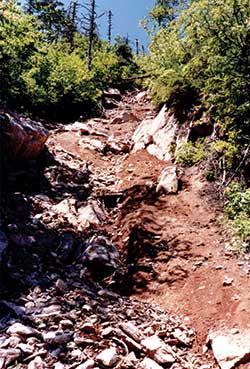
Landslides

Steep mountain slopes, coupled with events such as intense rainfall, freeze – thaw cycles, earthquakes, and major forest harvesting practices are some of the major triggers of landslides. In Nova Scotia, however, due to the nature of our bedrock geology and topography, regulations with respect to forest-harvesting practices, and general lack of major landslide triggers, the risk to people and infrastructure from landslides is minimal compared to many areas in the world. Nonetheless, shallow landslides and rock slides pose a significant risk to infrastructure, particularly highways, in areas with steep topography such as the Cape Breton Highlands.

Cyclical periods of spruce budworm deforestation have been found to be a major triggering mechanism of avalanches in the Cape Breton Highlands. Budworm infestation selectively kills softwood, and where softwood is the predominant species on steep slopes, death of the roots creates ideal conditions for formation of high velocity debris slides.
Landslides carry large amounts of debris down slope and have been observed to temporarily block or partially block streams and rivers in the Cape Breton Highlands. Avalanches, such as the one shown on the left input large amounts of sediment into important salmon spawning rivers such as the Margaree River.

In Nova Scotia earth slides and rotational slumps are common geohazards along one hundred series highways where deep cuts are made through drumlins. Varying soil composition and zones where water seeps out of the road embankments leads to instability, slumping, and requires geotechnical engineering solutions to stabilize the slopes.